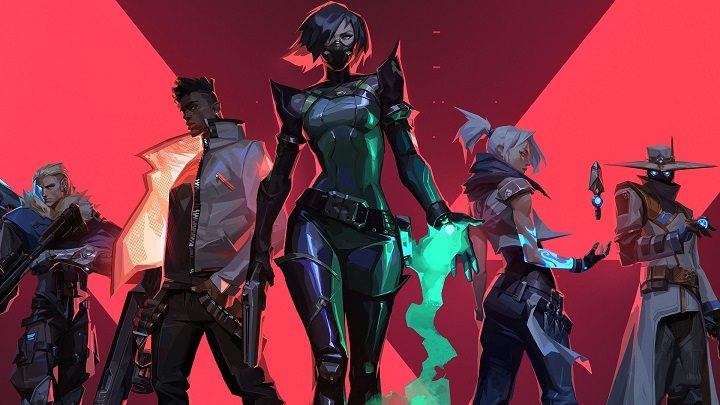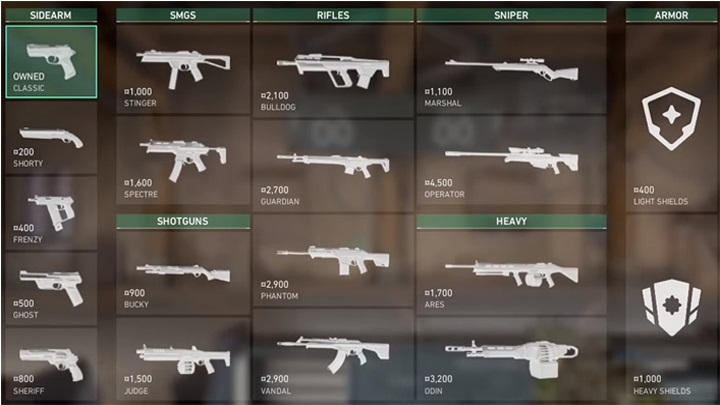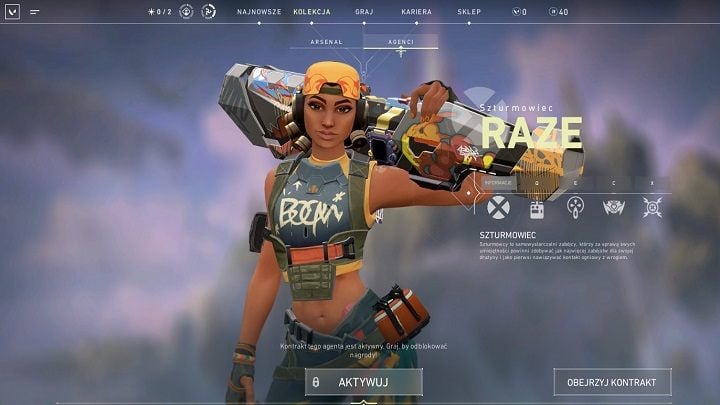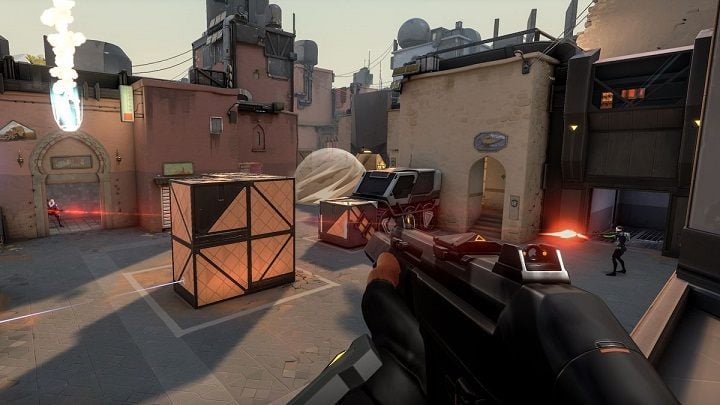Valorant Preview – I Love Shooters Again
The creators of the League of Legends have developed a shooter that behaves a lot like Counter Strike, feels a bit like Rainbow Six Siege, and features a visual setting reminiscent of Overwatch. There's no originality here, but it's still fun.
I always valued competitive network games over single-player productions. I’ve spent most of my gaming days playing League of Legends, but the drive of my PC hosted a slew of genres – from card games to shooters. Needless to say, I was pretty excited when Riot finally announced they will be creating big, new games. Already at that point, Valorant seemed the most interesting one to me. Even though I was never really crazy about shooting, I somehow felt I had to give this game a shot (no pun intended).
Now, after a few dozen hours with this game, I can safely say that it completely reinvigorated my love for FPS again (until now, I’ve only played Apex regularly), and my adventure with Valorant has barely started. Riot Games proves once again that they know how to create solid games, which, although not groundbreaking, bring a certain breath of fresh air to the party. There's still a long way to go before the game can be called a real success, though.
Valorant, or finding equilibrium
Some time ago, news appeared on the web, quoting a statement from an ESPN reporter who said that Valorant is a mix of CS:GO and Rainbow Six: Siege. I completely agree, and I want you to know that if somebody claims the above statement isn't true, it's likely because they haven't played any of these games. Valorant combines elements of both these games, and it does so in the best possible way.

But after getting past the initial impressions, which mostly have to do with the visuals, and checking out the systems, the feeling goes away. Indeed, the cornerstone of gameplay in Valorant is actually a calque of CS:GO's formula. You have two teams, one of which is attacking. They have two ways of winning the game: either plant the spike (a bomb) in the designated area, or just eliminate the defenders, for whom victory conditions are nearly identical, except they obviously need to disarm the bomb. Sounds like something incredibly original? Well, it almost does, except Counter-Strike invented that some 20 years ago. The major difference is that you need 13 rounds to win the match in Valorant. Even gunplay, the way the guns feel and look (all characters in Valorant use the same weapons) are very similar in both games.

So what does Valorant have in common with Rainbow Six: Siege? In the game by Ubisoft Montreal, we use operators – distinctive characters that have their own, unique gadgets and handle differently, which makes them fit for different purposes. It’s basically the same here. The characters (or rather Agents) have different classes, and their skills make them suitable for... different purposes. So, both games require teams to have appropriate consistency – that's the first step to victory – which also isn't something uncommon in the world of shooters (vide Team Fortress 2).
Sure, the skills allow the characters in Valorant to do a little crazier stuff, and hence are closer to those from Overwatch (Jett is extremely mobile, Sage can resurrect others), but here comes the catch. In Valorant, you don't get second chances. Timing, and precision, are essential – launching skills in the wrong moment may mean you won't be able to draw your gun, which often equals death, and since there's no respawning until the next round, it also means weakening the team.
When it comes to factors determining the overall capability of players, it's first, and foremost, shooting skills, then the knowledge of weapons and maps – as opposed to being able to perform some special moves. The characters' abilities are just a seasoning. A significant addition, but they're certainly not crucial.

Skills have to be used with caution and are often simply used to gain temporary tactical advantage (much like in Rainbow Six). They include rather ordinary (although clad in a fantasy mantle) flash and frag grenades, Molotov's cocktails, smokes, and drones that reveal enemy positions. Basic abilities are purchased every round in the store, and special abilities are activated through subsequent kills and rounds. Forget cooldown times and spamming that's so prevalent in Overwatch or Paladins.
Why does Valorat feel so good?
The creators of Valorant cherry-pick some of the best solutions we've recently had in online shooters, and blend them together. And this works really well. Distinctive characters and their skills provide a great tactical variety; at the same time, their skills won't save you if you don't know the map, or can't shoot very well.
This mix makes Valorant extremely enjoyable and, most importantly, diverse. . Also satisfying. . Let me give you an example, though.
? Playing several rounds in a row as Raze, I used a bot that tracks opponents, and I did that in the same place every time. Funnily enough, I killed the same opponent each of those times. When my special was ready again, I decided to change the approach a little: I didn't launch the bot the same way again, instead, I decided to try and hit the same enemy with a rocket, hoping that he or she would feel safe enough to get out in the open. Imagine my surprise, when I saw not one, but three enemies running from around the corner.
I guess that player must have been so frustrated with so many deaths in a row from the same move, they decided to bring some friends. Well, as they say, don't bring a knife to a gunfight. Surprised, but unabashed, with my special ready, I fired the rocket. The effect? A triple kill to my credit and an win. As you can see, spectacular moments do happen in Valorant, but they don't happen very often. Nine times out of ten you simply die from quick insertion of a small amount of led into your body.

What deserves high praise is that the game runs like a charm (I have never encountered any FPS drops), the animations are very clear, and the principles of gameplay are easy to learn. Some may look down on the visual setting of Valorant, which looks very bland and is a "true neutral" in graphical terms, but that's a trade-off, and when you play, you will likely be glad the game looks (and hence runs) as it does. The graphics are pretty cartoonish, but not in a bad way. The colors are well-balanced, and the game is generally very legible. Which is a huge advantage in my books.
Is Valorant a CS:GO slayer?
Nah. I mean, it's far too early to say that, even if it may potentially be true in the future. Valorant, even though it feels great, isn't perfect. There's a lot of room for improvements – almost all the weapons look the same (they're virtually indistinguishable when they're lying on the ground), the balance of both maps and characters could be better, and the game's client is weak and very unintuitive. CS: GO is currently experiencing its renaissance and it doesn't look like it's going to give up without a fight. If you ask me, I'd say the games will just end up living side by side.
Valoranta's position on the e-sports scene will also be a key factor in determining the game's success. Riot Games knows exactly how to keep fans interested for many years (vide League of Legends), and the only company that can equal them in this respect is Valve. Ultimately, the success of Valorant will depend on how much effort will go into the development, and whether the design decisions remain accurate.

Valorant will not be universally appealing, and it does not hit any particular niche. People who prefer militaristic quasi-realism will wave it off and return to Battlefield, R6: Siege and Call of Duty. Those who prefer quick, dynamic clashes are largely catered to already by Apex; fans of slower, precise gunplay have, of course, Counter-Strike. On the other hand Valorant is already the second most-viewed game on Twitch, having recently attracted 1.7 million people. The game is not trying to reinvent the wheel. It simply combines some tried solutions, but does it skilfully. And though it may not seem as much, this should be reason alone for the game to stay afloat for long. There's no doubt Riot Games knows how to maintain their games, so their new shooter seems doomed to success. I enjoy network games and I enjoyed Valorant. The only thing that was missing were my friends, and I look forward for the moment we get to play together. If you've also participated in the closed beta, don't forget to share your impression in the comments below.